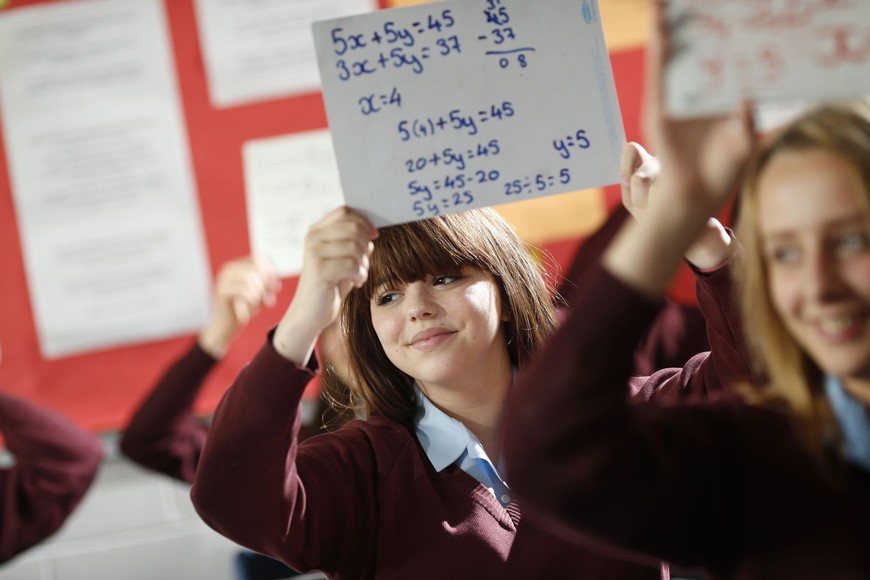MATHEMATICS

Department vision
Mathematics is important in our everyday life, allowing us to make sense of the world around us and to manage our lives. Using mathematics enables us to model real-life situations and make connections and informed predictions. It equips us with the skills we need to interpret and analyse information, simplify and solve problems, assess risk and make informed decisions.”
We aim to encourage students to develop lively, creative and enquiring minds. To be capable of independent thought and to enjoy Mathematics through problem solving and perseverance. To appreciate that Mathematics is inherent to everyday life.
Year 7
| Learning Outcomes | |
| Term 1 and 2 | . Primes, Factors & Multiples HCF & LCM Negative Numbers Multiplication Index Notation Estimation Simplifying Expressions Substitution Deriving Formulae Expanding single brackets Factorising single brackets Simplifying Fractions Improper and mixed fractions Equivalent fractions, decimals and percentages. Fractions of amounts Add and subtract mixed numbers. Divide and multiply fractions Primary & Secondary Data Choosing Sample Sizes Bias Random Sampling Two-way tables Bar charts Compound bar charts Averages and range Grouped data More graphs inc line graphs. Pie charts, Scatter graphs and correlation Angles and parallel lines Measuring and drawing angles Properties of triangles inc isosceles and equilateral Angles in a triangle Types of quadrilaterals, angles in quadrilaterals including proofs Interior & Exterior Angles of a Polygon Calculating missing angles Lines of Symmetry & Rotational Symmetry, |
| Term 3 and 4 | Ordering Decimals, Rounding Decimals, Adding & Subtracting Decimals. Multiplying decimals, dividing decimals, fractions, decimals and percentages. Using the multiplier. Percentages of Amounts. Solving equations with one operation, forming and solving equations. Solving equations with two operations. Solving equations with unknowns on both sides and with brackets. Trial and Improvement. Convert metric and imperial units, writing ratios, sharing in a given ratio Proportion, proportional reasoning, using the unitary method Sequences, term to term rule, the nth term, pattern sequences |
| Term 5 and 6 | Coordinates and line segments, graphs including straight lines parallel to axis, y=x and y=-x Area of triangles, parallelograms and trapezium. Perimeter and area of compound shapes. Properties of 3D solids Surface area, Volume of prisms, convert between metric measures for area and volume. |
Year 8
| TERM | LEARNING OUTCOME |
|---|---|
| 1 and 2 | Prime factor decomposition, finding the HCF & LCM. Laws of indices Powers of 10 Calculations with powers Significant Figures. Simplifying expressions, identities Using index laws Expanding and factorising single brackets Substituting and solving equations Plotting straight line graphs, finding the y intercept, finding the gradient. Y=mx+c Parallel and Perpendicular Lines. Non-linear graphs. Line segments Direct Proportion Using Graphs Financial graphs distance-time graphs Interpreting real-life graphs, including curved graphs misleading graphs. |
| 3 and 4 | Perimeter Area and Volume of shapes after enlargement. Volume of Prisms. Circumference and Area of a Circle including Sectors and Arcs Volume and Surface Area of a Cylinder. Pythagoras’ Theorem Translations Reflections Rotation Enlargement Negative & Fractional Enlargement Combining Transformations Recurring decimals into fractions. The percentage multiplier Using reverse percentages Percentage change compound interest Calculating Probabilities Mutually Exclusive Events estimating probability & relative frequencies. Experimental Probability Sample Space Diagram Venn Diagrams Tree Diagrams |
| 5 and 6 | Scales in maps Bearings Drawing diagrams to scale Congruent and similar shapes. Interior and Exterior Angles. Solving Geometry Problems. Drawing triangles using ruler & protractor Drawing diagrams to scale. Triangles using ruler & compass drawing accurate nets. Bisect a line using a ruler and compass. Construct perpendicular lines. Bisect Angles. Loci. Nets of solids Plans & Elevations. Surface area of Prisms |
Year 9
| TERMS | LEARNING OUTCOMES |
|---|---|
| 1 and 2 | Expanding brackets Factorising by common factors Expanding the product of two brackets. Factorising by grouping. Factorising quadratics including with coefficient of x2>1 Factorising difference of two squares. Number problems and reasoning Place value and estimating HCF & LCM Calculating with Powers, Zero, negative and fractional indices. Powers of 10 and standard form. Surds. Angle properties of triangles and quadrilaterals. Interior & Exterior Angles of a polygon. Pythagoras’ Theorem. Trigonometry. |
| 3 and 4 | Add, subtract, multiply & divide fractions, reciprocals. Using ratio. Ratio & Proportion. Percentages. FDP. Recurring Decimal to Fraction. Algebraic Indices. Algebraic Fractions, Simplify, multiply and divide. Linear equations, setting up equations and solving. Formulae. Linear Sequences, Non-Linear Sequences. Linear Graphs, Gradients, y intercept, y=mx+c, finding the equation of a line. Line segments. |
| 5 and 6 | Graphing rates of change. Real-life graphs. Quadratic Graphs. Cubic & Reciprocal graphs More graphs. Stem & Leaf, Frequency Polygons, Pie Charts, Time Series, Trends, Scatter Graphs. Line of best fit. Averages and range. Two-way tables, selecting diagrams, misleading graphs. 3D Solids Reflection & Rotation Enlargement. Translations & Combinations, Bearings & Scale Drawings, Constructions. Loci. |
Years 10 & 11
Year 10
| TERM | LEARNING OUTCOMES |
|---|---|
| 1 and 2 | Linear Graphs, Gradients, y intercept, y=mx+c, finding the equation of a line. Graphing rates of change. Real-life graphs Line segments. Quadratic Graphs. Cubic & Reciprocal graphs. More graphs. 3D Solids. Reflection & Rotation. Enlargement. Translations & Combinations. Bearings & Scale Drawings. Constructions. Perimeter & Area. Units & Accuracy. Prisms. Circles, Sectors. Cylinders and spheres Pyramids and cones |
| 3 and 4 | Solving quadratic equations including coefficient >1. Completing the square. Solving simultaneous equations including linear and quadratic equations. Solving linear inequalities. Growth & Decay. Compound Measures More Compound Measures. Ratio & Proportion. Kinematics. Combined events. Sample space Mutually exclusive events Experimental probability. Independent Events. Tree Diagrams. Conditional Probability. Venn Diagrams & Set Notation |
| 5 and 6 | Congruence. Geometric Proof & congruence. Similarity More Similarity. Similarity in 3D Solids Using upper and lower bounds with Trig Using the Sine Function. Using the cosine and tangent function. Calculating areas and the sine rule. Cosine rule. 2D & 3D trigonometric problems. Transforming trig graphs. |
Year 11
| TERM | LEARNING OUTCOMES |
|---|---|
| 1 and 2 | Sampling. Cumulative Frequency Box Plots. Drawing and interpreting Histograms. Comparing and describing populations Using upper and lower bounds with Trig. Using the Sine Function. Using the cosine and tangent function. Calculating areas and the sine rule. Cosine rule. 2D & 3D trigonometric problems. Transforming trig graphs. Representing inequalities graphically, graphs of quadratic functions. Solving quadratic equations graphically. Graphs of cubic functions. |
| 3 and 4 | Radii & chords. Tangents Angles in circles, all Theorems. Applications of Circle Theorems Rearranging formulae. Algebraic fractions. Simplifying fractions More algebraic fractions. Surds Solving algebraic fraction equations. Vectors and vector notation Vector arithmetic, more vector arithmetic. Parallel Vectors and collinear points. Solving geometric problems Direct & Inverse Proportion. Exponential functions Non-linear graphs Translating graphs of functions. Reflecting and stretching graphs of functions. |
Post 16 at WG6
Year 12
| Topic | Learning Outcomes | |
| Term 1 | Pure 1: Algebraic Expressions Pure 2: Quadratics Pure 3: Equations and Inequalities Pure 4: Graphs and Transformations Pure 12: Differentiation Pure 5: Straight Line Graphs | Index Laws Expanding Brackets Factorising Negative and Fractional Indices Surds Rationalising Denominators 2.1 Solving Quadratic Equations 2,2 Completing the Square 2.3 Functions 2.4 Quadratic Graphs 2.5 The Discriminant 2.6 Modelling with Quadratics 3.1 Linear Simultaneous Equations 3.2 Quadratic Simultaneous Equations 3.3 Simultaneous Equations on Graphs 3.4 Linear Inequalities 3.5 Quadratic Inequalities 3.6 Inequalities on Graphs 4.1 Cubic Graphs 4.2 Quartic Graphs 4.3 Reciprocal Graphs 4.4 Points of Intersection 4.5 Translating Graphs 4.6 Stretching Graphs 4.7 Transforming Functions 12.1 Gradients of Curves 12.2 Finding the Derivative 12.3 Differentiation xnxn 12.4 Differentiation Quadratics 12.5 Differentiation functions with two or more terms 12.6 Gradients, tangents and normal 12.7 Increasing and decreasing functions 12.8 Second order derivatives 12.9 Stationary Points 12.10 Sketching gradient functions 12.11 Modelling with differentiation 5.1 y=mx+cy=mx+c 5.2 Equations of straight lines 5.3 Parallel and perpendicular lines 5.4 Length and area 5.5 Modelling with straight lines |
| Term 2 | Pure 11: Vectors Stats 1: Data Collection Stats 2: Measures of Location and Spread Stats 3: Representations of Data Stats 4: Correlation Mechs 8: Modelling in Mechanics Mechs 9: Constant Acceleration Pure 6: Circles | 11.1 Vectors 11.2 Representing vectors 11.3 Magnitude and direction 11.4 Position vectors 11.5 Solving geometric problems 11.6 Modelling with vectors Populations and samples Sampling Non-random sampling Types of data The large data set 2.1 Measures of Central Tendency 2.2 Other Measures of Location 2.3 Measures of Spread 2.4 Variance and Standard Deviation 2.5 Coding 3.1 Outliers 3.2 Box Plots 3.3 Cumulative Frequency 3.4 Histograms 3.5 Comparing Data 4.1 Correlation 4.2 Linear Regression 8.1 Constructing a Model 8.2 Modelling Assumptions 8.3 Quantities and Units 8.4 Working with Vectors 9.1 Displacement-time Graphs 9.2 Velocity-time Graphs 9.3 Constant Acceleration Formulae 1 9.4 Constant Acceleration Formulae 2 9.5 Vertical Motion Under Gravity 6.1 Midpoints and Perpendicular Bisectors 6.2 Equation of a Circle 6.3 Intersections of Straight Lines and Circles 6.4 Use Tangent and Chord Properties 6.5 Circles and Triangles |
| Term 3 | Pure 13: Integration Pure 9: Trigonometric Ratios Pure 10: Trigonometric Identities and Equations Pure 14: Exponentials and Logarithms Mechs 10: Forces and Motion | 13.1 Integrating xnxn 13.2 Indefinite Integrals 13.3 Finding Functions 13.4 Definite Integrals 13.5 Areas under Curves 13.6 Areas under the x-axis 13.7 Areas between Curves and Lines 9.1 The cosine rule 9.2 The sine rule 9.3 Areas of Triangles 9.4 Solving triangle problems 9.5 Graphs of sine, cosine, and tangent 9.6 Transforming trigonometric graphs 10.1 Angles in all four Quadrants 10.2 Exact values of trigonometrical ratios 10.3 Trigonometric Identities 10.4 Simple Trigonometric Equations 10.5 Harder Trigonometric Equations 10.6 Equations and Identities 14.1 Exponential Functions 14.2 y=exy=ex 14.3 Exponential Modelling 14.4 Logarithms 14.5 Laws of Logarithms 14.6 Solving Equations using Logarithms 14.7 Working with Natural Logarithms 14.8 Logarithms and Non-Linear Data 10.1 Force Diagrams 10.2 Forces as Vectors 10.3 Forces and Acceleration 10.4 Motion in 2 Dimensions 10.5 Connected Particles 10.6 Pulleys |
| Term 4 | Stats 5: Probability Stats 6: Statistical Distributions Mechs 11: Variable Acceleration Pure 7: Algebraic Methods | 5.1 Calculating Probabilities 5.2 Venn Diagrams 5.3 Mutually Exclusive and Independent Events 5.4 Tree Diagrams 6.1 Probability Distributions 6.2 The Binomial Distributions 6.3 Cumulative Probabilities 11.1 Functions of time 11.2 Using differentiation 11.3 Maxima and minima problems 11.4 Using integration 11.5 Constant acceleration formulae 7.1 Algebraic Fractions 7.2 Dividing Polynomials 7.3 The factor theorem 7.4 Mathematical Proof 7.5 Methods of Proof |
| Term 5 | Stats 7: Hypothesis Testing Pure 8: The Binomial Expansion | 7.1 Hypothesis Testing 7.2 Finding Critical Values 7.3 One-tailed tests 7.4 Two-tailed tests 8.1 Pascal’s Triangle 8.2 Factorial Notation 8.3 The Binomial Expansion 8.4 Solving Binomial Problems 8.5 Binomial Estimation |
| Term 6 | (Y13) Pure 5: Radians (Y13) Pure 1: Algebraic Methods (Y13) Pure 2: Functions and Graphs (Y13) Pure 4: Binomial Expansion | 5.1 Radian Measure 5.2 Arc Length 5.3 Areas of Sectors and Segments 5.4 Solving Trigonometric Equations 5.5 Small Angle Approximations Proof by Contradiction Algebraic Fractions Partial Fractions Repeated Factors Algebraic Division 2.1 The Modulus Function 2.2 Functions and Mapping 2.3 Composite Functions 2.4 Inverse Functions 2.5 y=|f(x)|y=f(x) and y=f(|x|)y=f(x) 2.6 Combining Transformations 2.7 Solving Modulus Problems 4.1 Expanding (1+x)n(1+x)n 4.2 Expanding (a+bx)n(a+bx)n 4.3 Using Partial Fractions |
Year 13
| Topic | Learning Outcomes | |
| Term 1 | Pure 2: Functions and Graphs Pure 3: Sequences and Series Pure 4: Binomial Expansion Mechs 5: Forces and Friction Mechs 6: Projectiles Pure 6: Trigonometric Functions | 2.1 The Modulus Function 2.2 Functions and Mapping 2.3 Composite Functions 2.4 Inverse Functions 2.5 y=|f(x)|y=f(x) and y=f(|x|)y=f(x) 2.6 Combining Transformations 2.7 Solving Modulus Problems 3.1 Arithmetic Sequences 3.2 Arithmetic Series 3.3 Geometric Sequences 3.4 Geometric Series 3.5 Sum to Infinity 3.6 Sigma Notation 3.7 Recurrence Relations 3.8 Modelling with Series 4.1 Expanding (1+x)n(1+x)n 4.2 Expanding (a+bx)n(a+bx)n 4.3 Using Partial Fractions 5.1 Resolving Forces 5.2 Inclined Planes 5.3 Friction 6.1 Horizontal Projection 6.2 Horizontal and Vertical Components 6.3 Projection at any Angle 6.4 Projectile motion formulae 6.1 Secant, cosecant and cotangent 6.2 Graphs of sec x, cosec x and cot x 6.3 Using sec x, cosec x and cot x 6.4 Trigonometric Identities 6.5 Inverse Trigonometric Functions |
| Term 2 | Pure 7: Trigonometry and Modelling Pure 8: Parametric Equations Pure 9: Differentiation Stats 1: Regression, correlation and hypothesis testing Stats 2: Conditional Probability | 7.1 Addition Formulae 7.2 Using the angle addition formulae 7.3 Double-angle formulae 7.4 Solving Trigonometric Equations 7.5 Simplifying acosx ±bsinxacosâ¡x ±bsinâ¡x 7.6 Proving Trigonometric Identities 7.7 Modelling with Trigonometric Functions 8.1 Parametric Equations 8.2 Using Trigonometric Identities 8.3 Curve Sketching 8.4 Points of Intersection 8.5 Modelling with Parametric Equations 9.1 Differentiating sinx andcosxsinâ¡x andcosâ¡x 9.2 Differentiation exponentials and logarithms 9.3 The chain rule 9.4 The product rule 9.5 The quotient rule 9.6 Differentiating trigonometric functions 9.7 Parametric differentiation 9.8 Implicit differentiation 9.9 Using second derivatives 9.10 Rates of change Exponential models Measuring correlation Hypothesis testing for zero correlation 2.1 Set Notation 2.2 Conditional Probability 2.3 Conditional Probabilities in Venn Diagrams 2.4 Probability Formulae 2.5 Tree Diagrams |
| Term 3 | Stats 3: The Normal Distribution | 3.1 The normal distribution 3.2 Finding probabilities for normal distributions 3.3 The inverse normal distributions 3.4 The standard normal distribution 3.5 Finding |
Related Careers
Mathematics has applications in many other subjects including Science, Business Studies, Economics, Geography, Computing, Design and Psychology. Careers such as Engineering, Architecture, Accountancy and Actuarial Science will require strong Mathematical skills whilst Mathematics is a valued supporting subject for many other degrees and careers.
- Accountancy
- Actuarial Science
- Architecture
- Engineering
- Financial consultant
- Computer systems analyst
- Insurance Broker
- Marketing Executive







